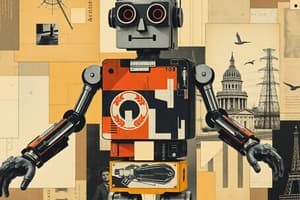Podcast
Questions and Answers
What is the interdisciplinary branch of computer science and engineering that involves the design, construction, operation, and use of robots called?
What is the interdisciplinary branch of computer science and engineering that involves the design, construction, operation, and use of robots called?
- Electrical engineering
- Biomedical engineering
- Robotics (correct)
- Mechanical engineering
What are the different fields that are integrated into robotics?
What are the different fields that are integrated into robotics?
- Mechanical engineering, electrical engineering, and computer engineering
- Mechanical engineering, electrical engineering, and information engineering (correct)
- Mechanical engineering, electrical engineering, and software engineering
- Mechanical engineering, electrical engineering, and biomedical engineering
What was the first digitally operated and programmable robot called and what was its purpose?
What was the first digitally operated and programmable robot called and what was its purpose?
- Unimate, to lift hot pieces of metal from a die casting machine and stack them (correct)
- Unimate, to assemble and pack consumer goods
- Robonaut, to assemble and pack consumer goods
- Robonaut, to lift hot pieces of metal from a die casting machine and stack them
What are the two types of end-effectors in robotics?
What are the two types of end-effectors in robotics?
What is the most common type of end-effector in robotics?
What is the most common type of end-effector in robotics?
What locomotion method provides even more traction than a six-wheeled robot?
What locomotion method provides even more traction than a six-wheeled robot?
What is the term used to describe the level of advancement of a robot?
What is the term used to describe the level of advancement of a robot?
What is the robotics industry expected to grow to by 2030?
What is the robotics industry expected to grow to by 2030?
What is the Socially Intelligent Machines Lab of the Georgia Institute of Technology researching?
What is the Socially Intelligent Machines Lab of the Georgia Institute of Technology researching?
Flashcards
Robotics definition
Robotics definition
Robotics is the design, construction, operation, and use of robots.
Robot actuators
Robot actuators
Actuators are robot parts that convert energy to movement, like 'muscles'.
Robot sensors
Robot sensors
Sensors provide information about the environment or internal robot components.
End-effectors (grippers)
End-effectors (grippers)
Signup and view all the flashcards
Mobile robot locomotion
Mobile robot locomotion
Signup and view all the flashcards
Computer vision in robotics
Computer vision in robotics
Signup and view all the flashcards
Robot power sources
Robot power sources
Signup and view all the flashcards
Robotics applications
Robotics applications
Signup and view all the flashcards
Industrial robot use
Industrial robot use
Signup and view all the flashcards
Study Notes
Design, construction, use, and application of robots:
- Robotics is an interdisciplinary branch of computer science and engineering that involves the design, construction, operation, and use of robots.
- Robotics integrates fields of mechanical engineering, electrical engineering, information engineering, mechatronics engineering, electronics, biomedical engineering, computer engineering, control systems engineering, software engineering, mathematics, etc.
- Robots can be used in many situations for many purposes, including dangerous environments, manufacturing processes, and where humans cannot survive.
- Certain robots require user input to operate, while other robots function autonomously.
- The word "robotics" was derived from the word "robot", which was introduced to the public by Czech writer Karel Čapek in his play R.U.R.
- The first digitally operated and programmable robot, the Unimate, was installed in 1961 to lift hot pieces of metal from a die casting machine and stack them.
- Robots are widely used in manufacturing, assembly, packing and packaging, mining, transport, earth and space exploration, surgery, weaponry, laboratory research, safety, and the mass production of consumer and industrial goods.
- Robots use batteries, generators, or tethers as power sources.
- Actuators are the "muscles" of a robot, the parts which convert stored energy into movement.
- Sensors allow robots to receive information about a certain measurement of the environment, or internal components.
- Computer vision is the science and technology of machines that see.
- Robots need to manipulate objects; pick up, modify, destroy, or otherwise have an effect.Types of End-Effectors in Robotics and Locomotion Methods
End-Effectors:
- Grippers are the most common type of end-effectors and can have various designs, including mechanical and soft suction end-effectors.
- Hands that resemble human hands include the Shadow Hand, Robonaut hand, and Delft hand.
- Mechanical grippers can come in various types, including friction and encompassing jaws.
- Suction end-effectors, powered by vacuum generators, are very simple astrictive devices that can hold very large loads.
- Soft suction end-effectors can enable a robot to be more robust in the presence of imperfect robotic perception.
- Some advanced robots are beginning to use fully humanoid hands, like the Shadow Hand, MANUS, and the Schunk hand.
Locomotion:
-
Mobile robots can have four wheels or a number of continuous tracks, while some researchers have tried to create more complex wheeled robots with only one or two wheels.
-
Balancing robots generally use a gyroscope to detect how much a robot is falling and then drive the wheels proportionally in the same direction.
-
A one-wheeled balancing robot can move in any 2D direction using a round ball as its only wheel.
-
Several attempts have been made in robots that are completely inside a spherical ball, either by spinning a weight inside the ball, or by rotating the outer shells of the sphere.
-
Using six wheels instead of four wheels can give better traction or grip in outdoor terrain such as on rocky dirt or grass.
-
Tank tracks provide even more traction than a six-wheeled robot, and walking robots can be used for uneven terrains, which would provide better mobility and energy efficiency than other locomotion methods.
-
Several different approaches have been used to develop robots that have the ability to climb vertical surfaces, including mimicking the movements of a human climber on a wall with protrusions, using the specialized toe pad method of wall-climbing geckoes, and mimicking the motion of a snake climbing a pole.
-
Swimming robots would like to copy the type of locomotion used by fish, and notable examples include the Essex University Computer Science Robotic Fish G9 and the Robot Tuna built by the Institute of Field Robotics.Advances in Robotics: From Swimming Robots to Artificial Emotions
-
Swimming robots have been developed with the ability to attain speeds of up to 3.7 m/s through the application of a full-body length carangiform swimming motion.
-
Sailboat robots, which are powered by wind energy, have been developed for ocean surface measurements. They are equipped with solar panels, which means they could navigate indefinitely.
-
Navigation hardware and software are essential for robots to operate autonomously in dynamic environments. Robots such as ASIMO and Meinü have advanced navigation hardware and software, while self-controlled cars and the entries in the DARPA Grand Challenge use GPS navigation devices combined with other sensory data for better navigation.
-
Social robots that interact with humans need to have extremely intuitive interfaces because people who interact with them may have little or no training in robotics. Science fiction authors assume that robots will eventually be able to communicate with humans through speech, gestures, and facial expressions.
-
Speech recognition has evolved from the first "voice input system" that recognized "ten digits spoken by a single user with 100% accuracy" in 1952 to the best systems that can recognize continuous, natural speech, up to 160 words per minute, with an accuracy of 95%.
-
Synthetic voice is suboptimal as a communication medium for robots, making it necessary to develop the emotional component of robotic voice through various techniques such as diphonic branching.
-
Gestures are expected to play a part in the interaction between humans and robots, and many systems have been developed to recognize human hand gestures.
-
Robotic faces have been constructed using elastic polymers that allow a large number of facial expressions due to the elasticity of the rubber facial coating and embedded subsurface motors. Robots such as Kismet and Nexi can produce a range of facial expressions, allowing them to have meaningful social exchanges with humans.
-
Artificial emotions can be generated, composed of a sequence of facial expressions or gestures. An example of a robot with artificial emotions is Robin the Robot developed by an Armenian IT company Expper Technologies, which uses AI-based peer-to-peer interaction.
-
Researchers are trying to create robots that appear to have a personality, using sounds, facial expressions, and body language to try to convey an internal state, which may be joy, sadness, or fear.
-
The Socially Intelligent Machines Lab of the Georgia Institute of Technology researches new concepts of guided teaching interaction with robots that learn task and goals from human demonstrations without prior knowledge of high-level concepts.
-
Control systems may have varying levels of autonomy, and there are different classifications that take into account the interaction between human control and machine motions.
-
Research in robotics focuses on investigations into new types of robots, alternative ways to think about or design robots, and new ways to manufacture them. Open sourcing of robot-projects is a new innovation in robot design, and the term "Generation Robots" is used to describe the level of advancement of a robot.Overview of Robotics: Kinematics, Dynamics, Bionics, Quantum Computing, Education and Training, Employment, Occupational Safety and Health Implications, and User Experience
-
There are millions of industrial robots being used worldwide, with Japan having the highest density of robot usage in its manufacturing industry.
-
Robotics can be divided into kinematics and dynamics, with direct and inverse kinematics used for position and joint value calculation and direct and inverse dynamics used to study the effect of forces on robot movements.
-
Bionics and biomimetics apply the physiology and methods of locomotion of animals to the design of robots.
-
There has been some research into whether robotics algorithms can be run more quickly on quantum computers than digital computers, known as quantum robotics.
-
Robotics is used as an educational tool in some middle and high schools, raising interest in programming, artificial intelligence, and robotics among students.
-
Robotics-related jobs are steadily rising as factories increase their use of robots, leading to increased productivity and efficiency savings.
-
The robotics industry was worth $45bn in 2020 and is expected to grow to $568bn by 2030, driving jobs in robotics and related industries.
-
Robotics presents both opportunities and challenges for occupational safety and health, with autonomous robots being useful in replacing human workers performing dirty, dull, or unsafe tasks.
-
The need to combine optimal skills has resulted in collaborative robots and humans sharing a common workspace, leading to the development of new approaches and standards to guarantee the safety of the "man-robot merger".
-
User experience begins with an understanding of the robot's intended task and environment while considering any possible social impact the robot may have on human operations and interactions with it.
Studying That Suits You
Use AI to generate personalized quizzes and flashcards to suit your learning preferences.




